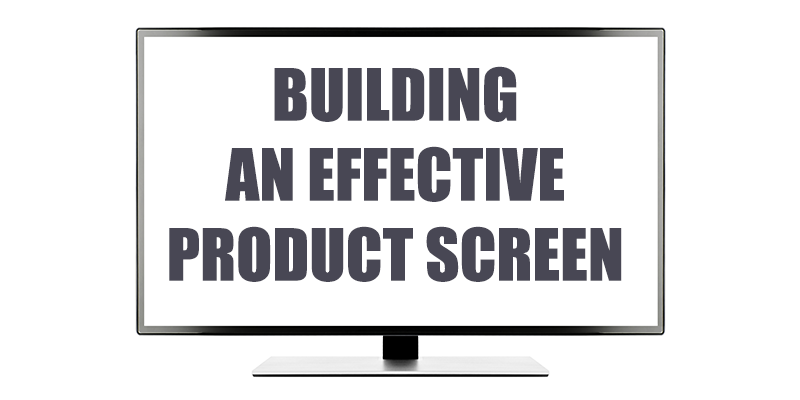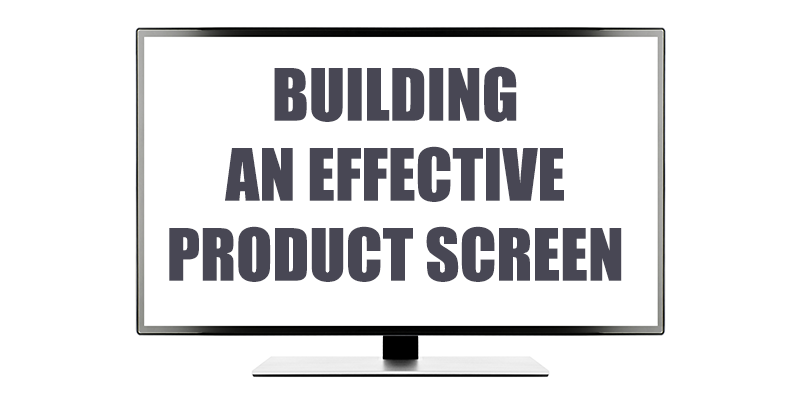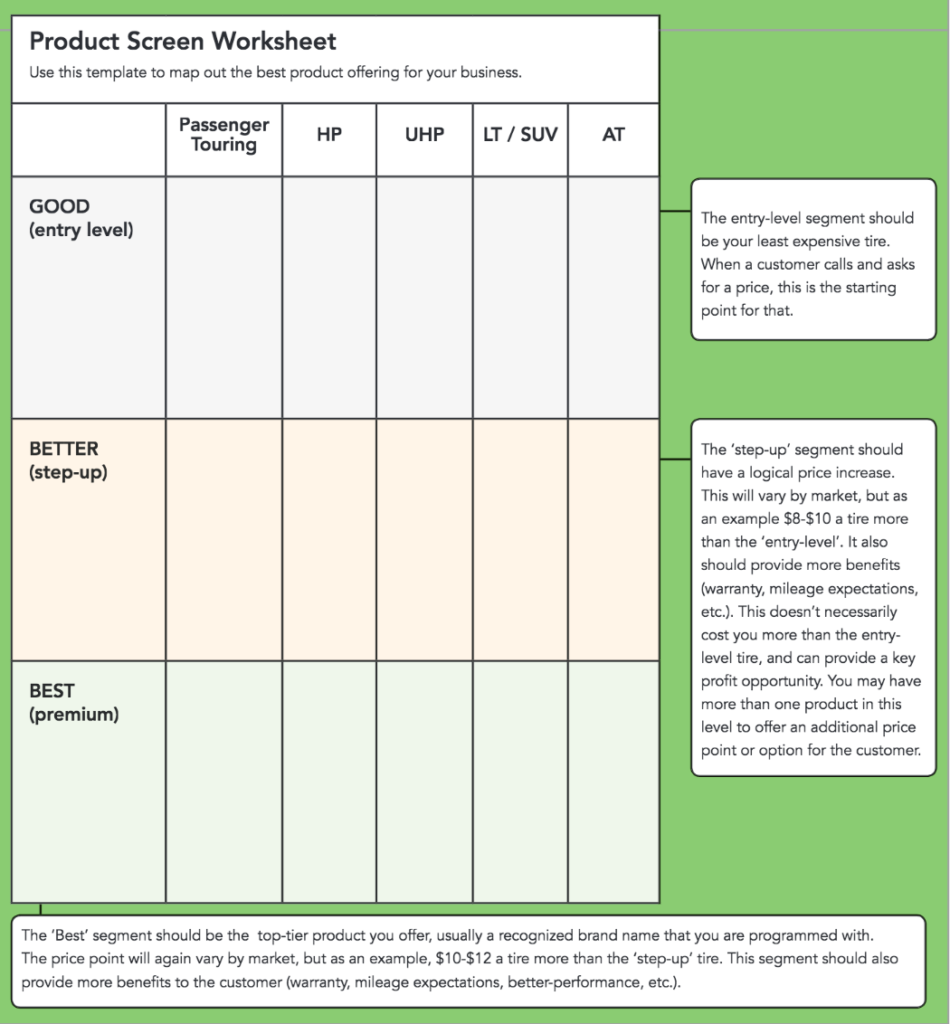“You can’t be all things to all people.” I’m sure you’ve heard that statement and, as business owners, we constantly try to be all things to our customers. I believe it’s driven by the fear of losing a sale. That’s understandable because everything in business starts with selling something. Customers’ needs vary widely and if we don’t have what the customer wants when they want it, we may lose the opportunity.
So many dealers are not stocking tires today. Instead, they rely on distributors to deliver tires several times a day to fill their needs. In essence, the computer screen has become the product screen. This is not necessarily a bad thing, but doing business like this is trying to be all things to all people, and could be costing you additional profit opportunities. In April’s article I outlined three key pieces that I believe will make selling tires more profitable for your business:
2. Building the proper product screen
3. Making tires a priority with your sales team
This article will focus on “Building the Proper Product Screen.” This can be such an important part in improving tire sales and profitability, yet many dealers spend little time putting any effort into it.
Product screens are part of every business, and so often it seems that a simple approach may be the best. For decades, merchandisers have used a “Good-Better-Best” sales technique, most notably Sears. Correctly presented, it gives customers the ability to purchase the item that most closely fits their needs and their budget. When well executed, it provides an opportunity to upsell and increase sales and profits. Basically, it’s an organized approach to selling and becomes a simple process for your sales team to follow.
Product screens are not cast in stone and need to be modified from time to time. Case in point: General Motors. Longtime President Alfred P. Sloan once famously said his company offered “a car for every purse and purpose” or trying to be all things to all people. The idea was that with multiple brands at different price levels, buyers could move up from inexpensive Chevrolets to Pontiacs, Oldsmobiles, Buicks, and then Cadillacs. That approach worked for many years, but in the late 1960s the lines between the individual brands started to get blurry. The loss of identity (and other elements) began to make “a car for every purse and purpose” a liability rather than a feasible strategy. Over time, General Motors began to struggle with its identity and profits suffered. In 2008 when the recession hit our economy hard, they were forced to reevaluate their business and eliminate some of their brands. Pontiac was one of those iconic brands that was dropped. The problem was not sales, as Pontiac was the company’s third-best-selling brand behind Chevrolet and GMC and sold twice as many vehicles as Buick. General Motors didn’t break out profits by brand, and the problem for Pontiac was profitability. When the overall picture was evaluated, Pontiac and other brands were eliminated to stay solvent (along with a government bailout, of course).
There are many tire dealers reading this that are not that dissimilar to General Motors. They are trying to be all things to all people and looking at the overall picture not at the profitability by brand.
Success starts with developing a product screen that best fits your business. The process to building a good product screen is straightforward, and the objective is to develop an organized, profitable selling approach. Below is a very simple template that can be used to develop your product screen. It uses a basic “Good-Better-Best” format and breaks it down to segments of the tire market. It can certainly be expanded to include other products, and in some cases multiple tire offerings in a particular segment.
There are several ideas that will make it easier to formalize your product screen. Let’s examine each of these a bit closer:
1. Look for the best fit in your local market.
2. An exclusive tire line is certainly an ideal situation, as it provides the opportunity to position it profitably without the fear of being undercut by competition. Exclusivity is tough to find today, but programming with a tire line that is not heavily promoted can offer a great profit opportunity. If you have not made the time to look at what the competition is doing, I would encourage you to do so. Many times, we think we know what is going on around us, and we don’t see the complete picture. Several years back, I was working with a dealer on their profitability issues. I was evaluating his competition and asked if Walmart was a factor since they were several miles away. He told me that they had little effect on his tire sales. When I stopped by to look for myself, I counted 180 tires being unloaded in the parking lot and a waiting room full of customers waiting for tires. That’s not seeing the entire picture.
- Carrying the proper assortment of products provides you the best opportunity of meeting your customers’ needs. Customers rely on you to take care of their vehicle, and if we do they may be less likely to shop with your competitors. By carefully monitoring your product mix and seeking feedback from your customers, you’ll be able to adjust as the needs of your customers change over time.
- Your product mix is important in determining the image of your business and company’s brand. It also helps you to maintain consistency in your target market. As an example, if your business is in a lower income market, introducing a premium priced product may hurt sales and could give customers the impression that you are too high priced. Conversely, if your market is a cross-section of income levels, you need to make sure you carry a prominent brand to appeal to the quality conscious customer as well as brands that fit the price buyer.
3. Organize and better control inventory.
- With daily delivery from tire distributors, many dealers are not inventorying tires. I’m not saying this is a bad approach, but it can be costing you profit opportunities as discussed in the April article. Formalizing a product screen helps you stay focused on the core tire brands. As business grows, you may be tempted to add more product lines in an effort to reach more customers. By doing so, you could be in danger of adding products that appeal only to a fraction of your customer base while alienating your core customers. Generally, your core customers provide about 80 percent of your business, so keep these customers in mind when thinking about changes to your product mix.
- Inventory management is key. As a small business owner, you probably face limitations regarding the number of products you can offer. By focusing on providing the optimum product mix for your customers, you’ll be able to weed out slow sellers and make room for faster moving tires. You won’t clutter precious selling and storage space with goods that won’t sell, you won’t tie up cash, and you’ll continuously offer the best tires for your customers.
4. Streamline and define profit opportunities.
- Buying tires takes constant attention. It’s easy to fall into a comfort zone and assume that you’re doing it right. Distributors want your business, and most have developed marketing opportunities with additional discounts. Couple this with manufacturer programs and the combined back-end discounts and it can be substantial. So often, dealers will be enrolled in numerous manufacturer programs. There’s nothing wrong with this approach, unless you find yourself not being able to take advantage of opportunities.
Here’s one example: “Dealer A” is signed up on multiple manufacturer programs with a distributor. It is often a struggle to reach purchase objectives or he falls between incentive levels. When this happens, he doesn’t maximize the impact of the backend enhancements and ultimately this hurts his profits. When product lines are consolidated and sales efforts focused, you may find out that you can earn additional back-end dollars that drop to the bottom line. Using Michelin’s MAST as an example, if you are buying at the “Bib-1” level and hit the objective of 500 units, you earn an enhancement of 2.5%. If you consolidated purchases and achieved the next purchase level of 800-units at “Bib-2,” you would earn 5.5%. Assume the average purchase price of $100 a tire — that’s an extra $3,150 to your bottom line (500 x $100 = $50,000 x 2.5% = $1,250 vs. 800 x $100 = $80,000 x 5.5% = $4,400). These are big numbers in a lower gross-profit segment, and in this case it means selling only about 6 additional tires a week of the MAST brand. Other flag and private brands have similar type programs and can help the profitability if you develop a plan to take advantage of these and stay focused.
- Timing is also paramount. Opportunities are often driven by the products that the distributors need to sell to reach their objectives. By staying on top of this, you’ll find this can add up to additional dollars that will drop to your bottom line. Competition is abundant, and everyone is hungry for business. Many programs offer back-end discounts and additional support programs. Loyalty to long-time suppliers is certainly important, but also realize what a couple of percentage points can mean to the bottom line.
5. Simplify retail selling options
- The people at the retail counter are busy, and a formalized product screen helps them stay focused on selling the tires that will best benefit the bottom line of the business. Share the reason for a focused effort with your entire staff so they understand. You may even want to consider adding a carrot if the plan objective is reached for your team.
- It takes salesmanship at times to sell a brand the customer did not request, but so many customers today do not have a brand preference. If salespeople take a few minutes to explain the features and benefits, the customer can often be convinced to purchase the recommended brand. Add to that a 30-day ride guarantee that they will be satisfied, and they will usually hand you the keys. As a fallback, if the customer demands a certain brand outside of the product screen, tell them the tires will be at your store on the next delivery and hit the order button on the online distributor portal. My next article in September will focus more on the sales aspect.
Tires may be a commodity today but shouldn’t be overlooked in your overall business plan. Customers tend to purchase service where they buy tires if the experience is positive, which helps boost the overall sales and profit picture. I would encourage you to not let the computer screen be your product screen. I’m not suggesting that you abandon the computer screen. The online distributor portals are an important element that most of us can’t do without. A product screen is equally as important because it provides direction for the entire business. It can help provide incremental profits that you may not be realizing by not having one in place. Most portals will allow you to limit what your salespeople can offer, which basically hides the brands that you don’t want to sell. This helps place the focus back on selling brands that are most important to your profitability.
You can’t be all things to all people, especially with the proliferation of SKUs today. If you make the time to formalize your product screen, your team will sell the brands you feel are important to your business plan. Inventory the most popular tires and sizes, and keep your salespeople focused on the objectives and you will realize greater profits. TR
An industry veteran of 40 years, Dave Crawford serves as a business consultant and trainer specializing in the evaluation of retail tire businesses for operational effectiveness. He can be reached at [email protected]
















